Estate Jewelry: Fable Rings, Space Bracelets, and Mystery Wirework
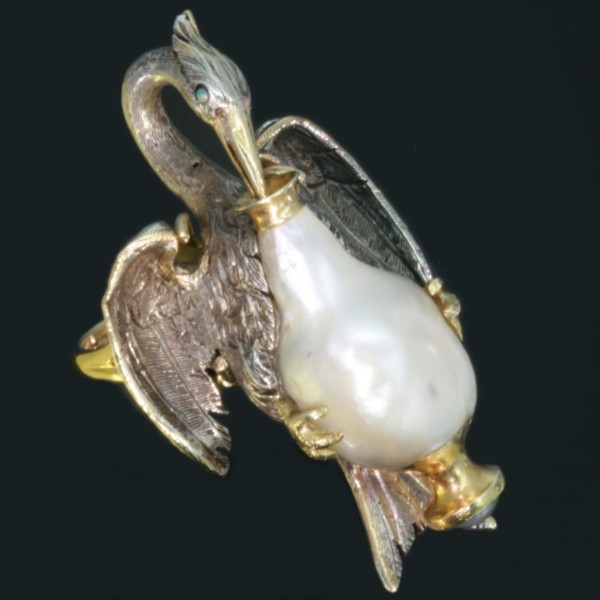
This fantastic ring, circa 1850–1870, is based on Aesop’s Fable “The Fox and the Stork,” in which a fox invites his friend, a stork, over for dinner. Being a wiseass, the fox serves the stork a shallow bowl of soup, which the stork is unable to eat due to his long beak. Even though he’s still hungry, the stork politely offers to return the visit, and invites the fox to dinner at a later date. When the fox arrives, the stork presents him with his meal in a long-necked jar with a narrow mouth. Despite his long snout, there is no way the fox could reach the contents. “I will not apologize for the dinner,” said the stork. “One bad turn deserves another.”
The dealer believes this piece, which depicts the stork eating from the jar, was created as part of a larger decorative object and set as a ring at a later date. The ring itself bears French hallmarks, but there are no marks on the stork — although the quality of workmanship leads the dealer to speculate that it was made by the house of François-Désiré Froment-Meurice, a Parisian goldsmith of the time who was renowned for working in a naturalistic style.
The stork consists of richly engraved silver with 18k gold accents, and the jar is a large baroque pearl. Another pearl forms the base of the jar, and tiny turquoise and onyx stones are used for the eyes. The ring base merely cradles the stork and holds it in place; it is not soldered or attached in any other way — a credit to the sensitivity of the jeweler who fashioned it.
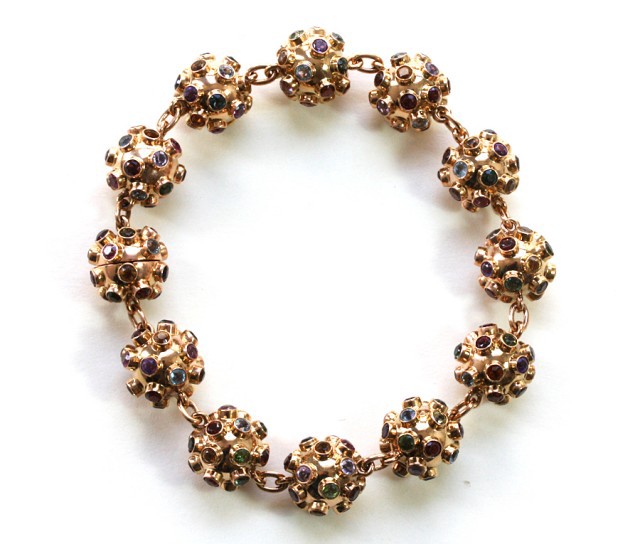
In 1957, the Russian satellite “Sputnik” was launched, and with it an iconic jewelry style. I’ve been digging around to see who first debuted the style, and it seems that, back in the 1950s, Brazilian jewelry house H. Stern created a line of jewelry designed to showcase the variety of gemstones mined in Brazil. Circular in shape and encrusted with bezel-set gems, the pieces were thought to resemble Sputnik, and thanks to the space race, the design was immediately popular. Its popularity endured, however, and many designers have revisited it since — in fact, Seaman Schepps included Sputnik pieces in their Spring 2012 collection, video here (although be warned, the proximity of intense red lipstick to white top in that video may give you agita. It certainly did for me).
This is an example of a Sputnik bracelet, circa 1957, consisting of twelve 18k gold spheres set with various gemstones. I think the endurance of the style can be attributed to the fact that it’s just so damned cute.
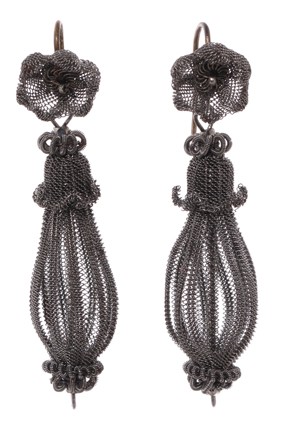
Silesian wirework is one of the mysteries of antique jewelry. Made of iron and steel, it dates to around the late 18th to the early 19th centuries and is often grouped in with Berlin Iron and cut steel jewelry. The thing is, we don’t know exactly who made it or where it came from. It may have been produced in Germany, France, or England, or in a part of Eastern Europe then known as Silesia, which covered parts of Poland, the Czech Republic, and Eastern Germany — but nobody really knows for sure. (And in her book Warman’s Jewelry Identification and Price Guide, jewelry historian Christie Romero called the very name “Silesian wirework” into question, suggesting it may have been coined by collectors.)
The jewelry itself is comprised of machine-made wire mesh that has been painstakingly manipulated into intricate forms; in this case long drops are suspended from small florets to create delicate earrings. Circa 1800, they’re made of iron mesh, and as a result are very light. The dealer also has a necklace available.
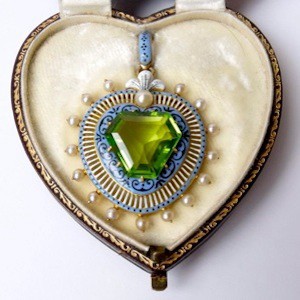
Have I mentioned that Carlo Giuliano is my favorite jeweler of all time? Oh, right, I have, in my very first column for the Hairpin. (I also later focused on his equally talented sons, Carlo Joseph and Arthur.)
This sweet little heart-shaped openwork pendant is by Carlo senior, and it pushes all of my buttons. Circa 1870, it features a particularly lovely peridot (which I think gets a bad rap, by the way, due to all the crappy home-shopping peridot jewelry on the market) within a frame of exquisite turquoise and navy enameling on gold, with a halo of pearl accents. It bears Carlo’s hallmark and *cough* my birthday’s this month *cough.*
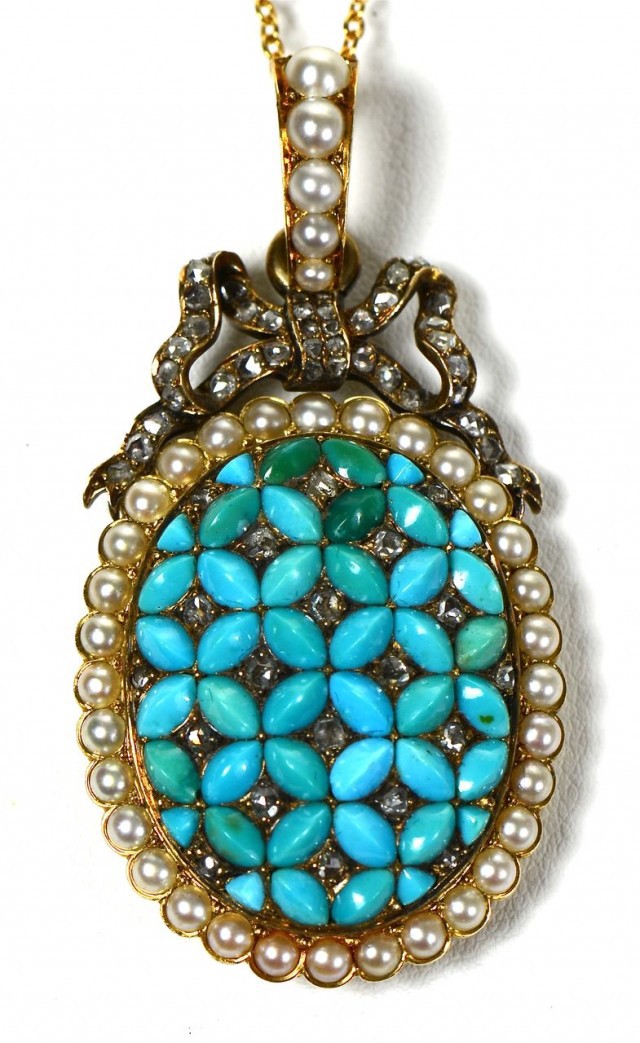
This 18k gold Victorian locket is beautiful, but it’s also a lesson. Be good to your turquoise, guys, because you see those darker stones? That’s what happens when oils come in contact with turquoise. It’s a pretty common thing, and sadly you can find lots of antique pieces that feature discolored, greenish turquoise. In the case of this locket, however, I think I actually prefer it, as the variations in color make the overall piece more interesting.
The locket also features rose-cut diamonds scattered among the turquoise, all set within a frame of pearls. A diamond-set bow and a pearl bale finish off the piece, which has a decidedly regal appearance. The back of the locket reveals a lock of blonde hair, preserved under beveled glass.
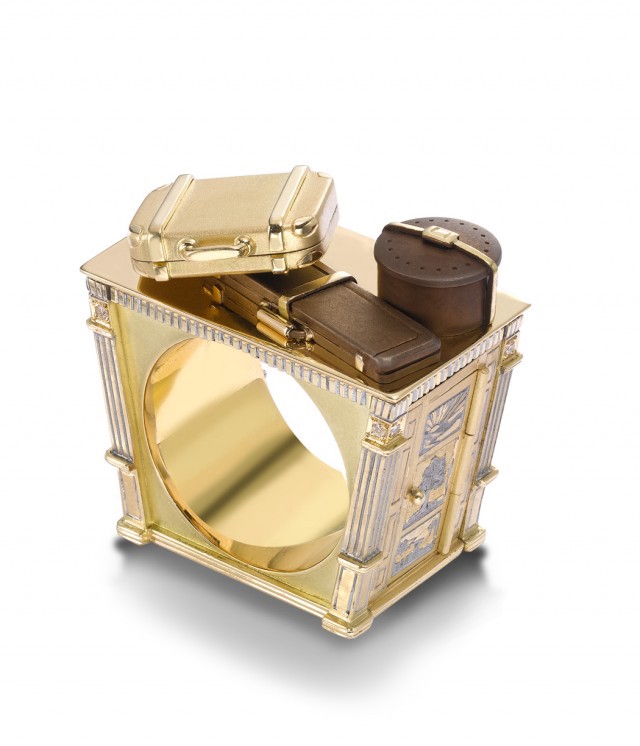
This is a contemporary piece by English jeweler Theo Fennell. Fennell makes beautiful jewelry, but his “Masterworks” delight me to no end. These are largely high-end whimsical pieces, and while their amazing workmanship and materials already set them apart, many of them also DO things: There’s a castle with a working drawbridge, a rock crystal igloo housing a tiny penguin, and a pyramid with an interior that contains a sarcophagus and removable mummy.
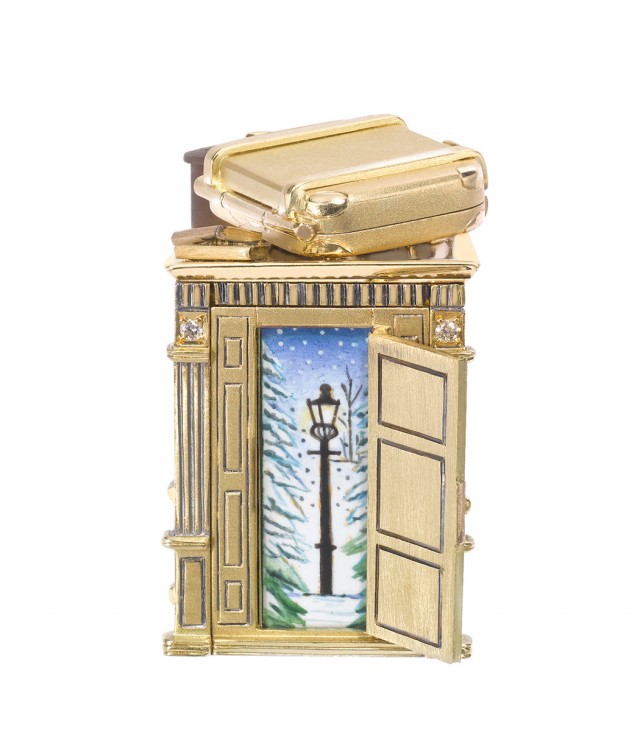
This 18k gold ring is inspired by C. S. Lewis’s beloved fantasy novel The Lion, The Witch and the Wardrobe, and features a suitcase (with a spider inside!), a hat box, and a gun case stacked on top of a wardrobe. Working doors on the sides of the wardrobe reveal enameled scenes of coats and the famous Narnia lamppost. Mr. Tumnus? Are you there?
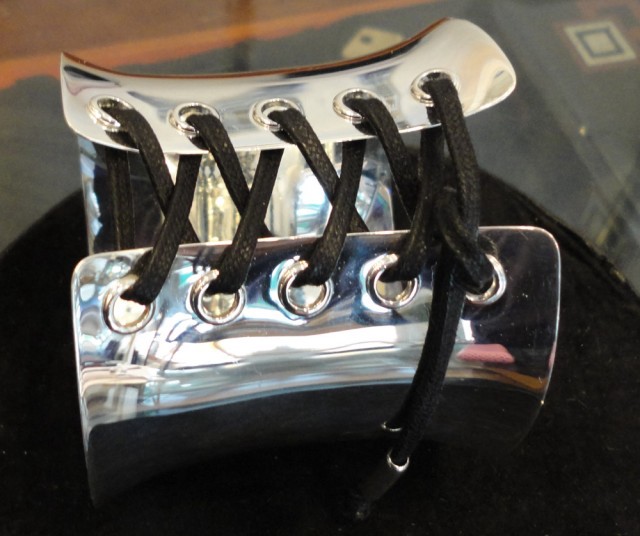
I’ve featured Georg Jensen jewelry in the past, but this bracelet dates to much later, as the Jensen company continued on after the great man’s death and became known for its stable of skilled designers and silversmiths. This corset-inspired sterling and waxed-cord bracelet was created by Regitze Overgaard, and it follows her body-conscious aesthetic, as the cuff fits over the wrist and can be adjusted to the width of the wearer’s arm.
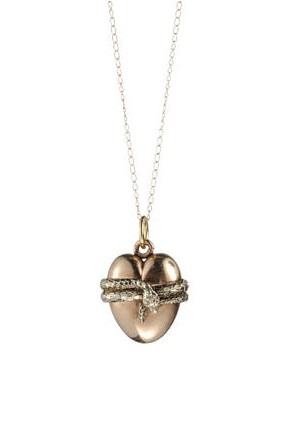
I’m slightly obsessed with snake jewelry, but I figure that’s okay, because the Victorians were, too. Snakes, you’ll remember, symbolized many things to the Victorians, including eternity, eternal love, good luck, protection, and/or wisdom, and, for their engagement, Prince Albert gave Queen Victoria a snake ring with an emerald set in its head.
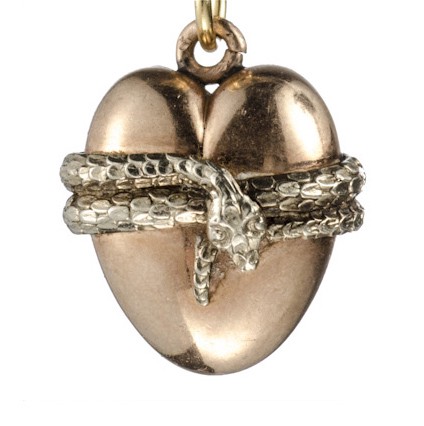
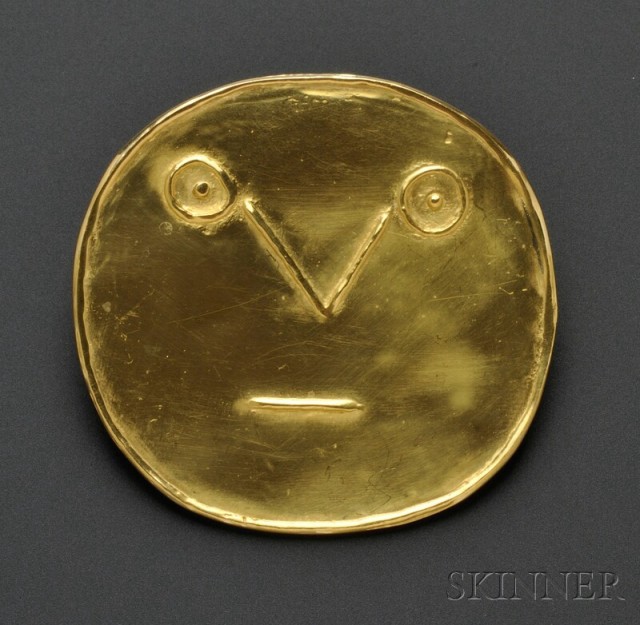
On September 11, the Boston auction house Skinner will hold a Fine Jewelry sale. Featuring a number of interesting pieces, the auction will also include the collection of Joan Sonnabend, who was renowned for showcasing jewelry created by many famous artists (including Man Ray, Picasso, and Calder) at her New York gallery Sculpture to Wear.
(Be sure to browse the rest of the auction; it features some great pieces, including this lovely French plique-a-jour enamel peacock pendant and this hysterical Tiffany & Co. walrus ring.)
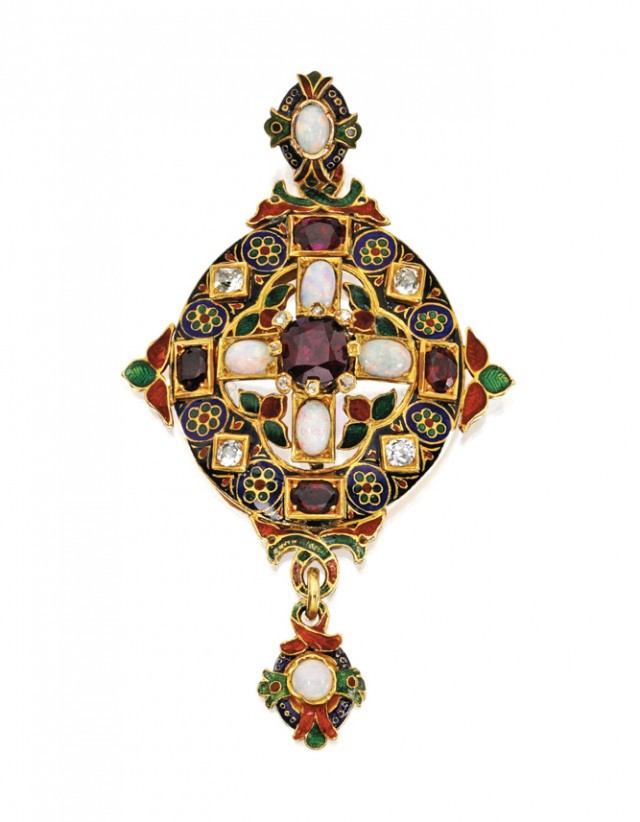
Sotheby’s New York also has a couple of interesting auctions coming up, including “Important Jewels” on September 20, and “Property from the Estate of Brooke Astor” on September 24–25.
There are some amazing items available in both sales. The Important Jewels auction is, as usual, loaded with big gems and big names — lots of David Webb — but I was particularly taken with lots 417 through 422. These items are listed as “property sold to benefit a community organization,” and they’re all fantastic examples of 19th-century opulence (including two beautiful pieces by the aforementioned Carlo Giuliano).
Look at this amazing Holbeinesque pendant. Circa 1870, the piece takes the usual Holbeinesque form, with a central stone (in this case, a ruby) surrounded by an elaborate openwork gold frame set with gemstones and enamel. A lozenge-shaped drop finishes the piece. The gemstones used are rubies, diamonds, and opals, and the enameling features scrolled and floral motifs in red, blue and green.
It would be worth going to Sotheby’s to see this piece in person, because the backs of items like this are often just as beautifully finished as the fronts — usually with intricate engraving. If you’re in town, check it out.
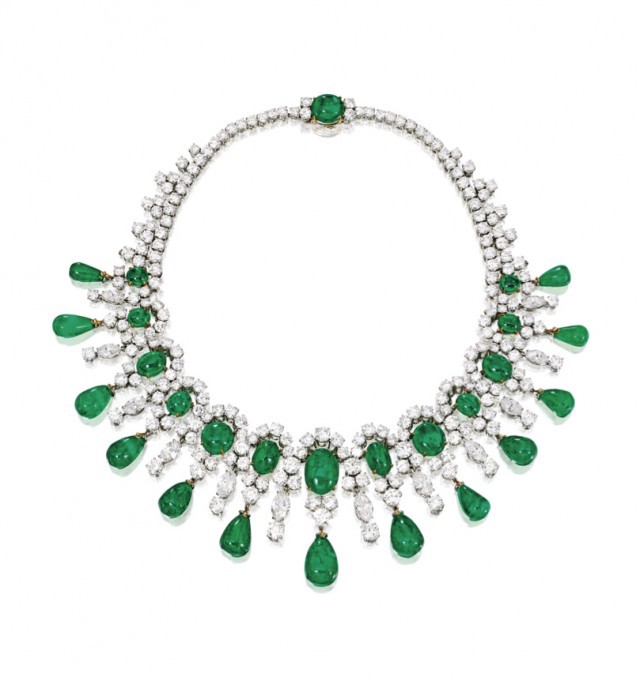
The Brooke Astor sale showcases an excellent, eclectic collection that runs the gamut from furniture to paintings (FYI, she reeeeally liked paintings of dogs), porcelain, and any number of decorative objects. The jewelry isn’t bad either, and the catalog lists this necklace as the last gift given to Mrs. Astor by her husband, Victor. Circa 1959, it’s by Bulgari, and features emeralds and diamonds set in platinum and 18k gold. The 13 emerald drops have a combined total weight of 71 carats, while the inner row of fourteen cabochon emeralds weighs 41 carats. The diamonds, both marquise and round, weigh approximately 58.50 carats in total. Quite a gift.
Previously: Sapphires, Marble Apples, and Fish With Crackers.
Monica McLaughlin’s gonna pop some tags, she’s only got twenty dollars in her pocket.